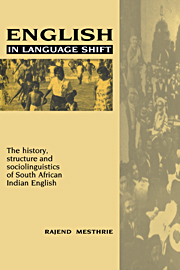 English in Language Shift
English in Language Shift Book contents
- Frontmatter
- Contents
- List of figures and maps
- List of tables
- Preface
- Acknowledgements
- List of abbreviations
- 1 Historical background: the shaping of a New English
- 2 Variation in SAIE: a first glimpse
- 3 Syntactic variation: the relative clause
- 4 Word-order principles
- 5 Non-syntactic variation
- 6 Perspectives from second-language acquisition
- 7 Perspectives from pidgin and creole studies
- Appendix A Comparison between SAIE sample and census data for Indians in Natal
- Appendix B Types of relative clauses used by individual speakers
- Appendix C Rank orders for relative clauses, topics and morphology
- Notes
- Sources and references
- Index
2 - Variation in SAIE: a first glimpse
Published online by Cambridge University Press: 03 December 2009
- Frontmatter
- Contents
- List of figures and maps
- List of tables
- Preface
- Acknowledgements
- List of abbreviations
- 1 Historical background: the shaping of a New English
- 2 Variation in SAIE: a first glimpse
- 3 Syntactic variation: the relative clause
- 4 Word-order principles
- 5 Non-syntactic variation
- 6 Perspectives from second-language acquisition
- 7 Perspectives from pidgin and creole studies
- Appendix A Comparison between SAIE sample and census data for Indians in Natal
- Appendix B Types of relative clauses used by individual speakers
- Appendix C Rank orders for relative clauses, topics and morphology
- Notes
- Sources and references
- Index
Summary
The gathering of data
In a panchronic analysis of the morphology and syntax of a dialect in the late stages of language shift, care has to be exercised in making the data base rich enough to glean all the nuances of natural speech. By panchronic is meant the study of language along both the synchronic and diachronic dimensions. I have already suggested in chapter 1 that there is much in the way of diachronic variation and change as the dialect has moved from rudimentary L3 to L2 to L1. On the synchronic level there is much fluctuation today according to the speaker variables of age, education, social class and ancestral language, and according to situational variables like purpose of the discourse, the nature of the audience/addressees, topic, etc.
A partial explanation for the enormous syntactic variety within SAIE is the uneven pace at which different speakers have moved towards English. As with Bickerton's well-known study of the Guyanese continuum, the movement can be shown to be ‘not without sidesteps and hesitations’ (1975: 17). That is, we are not dealing with a simple linear progression towards the standard, but with a complex system that allows for, and indeed covertly places high value upon, a measure of backsliding according to earlier norms of the L2. Bickerton (1975: 17) could well have been speaking of SAIE when he wrote:
a synchronic cut across the Guyanese community is indistinguishable from a diachronic cut across a century and a half of linguistic development, and that therefore a grammar of the whole Guyanese continuum should be indistinguishable from the diachronic grammar that could have been written if all Guyanese had moved as close to standard English as some of them have. […]
- Type
- Chapter
- Information
- English in Language ShiftThe History, Structure and Sociolinguistics of South African Indian English, pp. 34 - 70Publisher: Cambridge University PressPrint publication year: 1993


